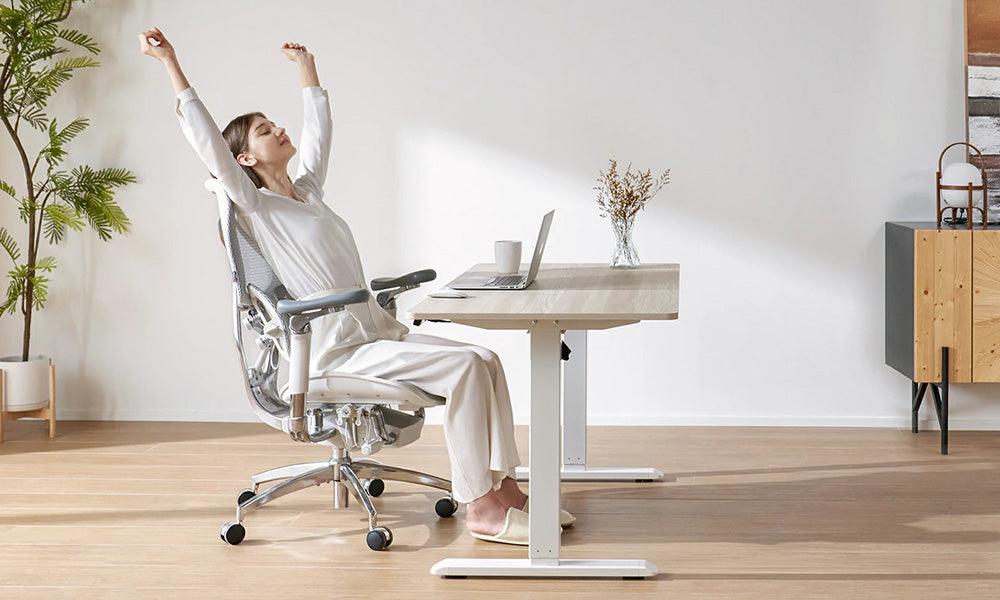In today's digital age, many of us spend a significant portion of our workday glued to our desks. This sedentary lifestyle can have a detrimental impact on our health, leading to issues like back pain, neck strain, and even an increased risk of heart disease. The good news is, there's a powerful duo that can help combat these problems: ergonomic chairs and height-adjustable tables.
This article explores the individual benefits of ergonomic chairs and height-adjustable tables, before diving deep into the combined advantages of using them together. We'll also explore some practical tips on setting up your workstation for optimal comfort and health.
The Power of Ergonomics: Benefits of Ergonomic Chairs
Ergonomic chairs are designed to provide optimal support for your body, promoting proper posture and reducing strain on your muscles and joints. Here are some key benefits of using an ergonomic chairs:
Improved Posture: A well-designed ergonomic chair encourages a neutral spine position, reducing hunching and slouching. This can significantly reduce back pain and discomfort.
Enhanced Circulation: Ergonomic chairs often have features like adjustable lumbar support and armrests, ensuring proper blood flow throughout the body. This can help prevent fatigue and improve focus.
Reduced Muscle Strain: By providing proper support for your back, neck, and arms, ergonomic chairs can significantly reduce muscle strain and pain.
Increased Comfort: Ergonomic chairs are designed for long periods of sitting, offering superior comfort compared to standard chairs. This can significantly improve your overall well-being at work.
While ergonomic chairs offer a multitude of benefits, it's important to remember that the human body isn't designed for prolonged sitting. This is where height-adjustable tables come into play.
The Freedom of Movement: Benefits of Height-Adjustable Tables
Height-adjustable tables allow you to effortlessly switch between sitting and standing positions throughout the workday. This simple yet powerful feature offers a variety of health benefits:
Reduced Risk of Sedentary Lifestyle Diseases: Sitting for extended periods is linked to an increased risk of heart disease, diabetes, and even certain cancers. Height-adjustable tables encourage movement, helping to mitigate these risks.
Improved Blood Flow and Circulation: Standing throughout the day promotes better blood flow throughout your body, keeping you energized and focused.
Reduced Back and Neck Pain: Switching positions regularly helps to alleviate pressure on your spine and discs, reducing back and neck pain.
Increased Productivity: Studies have shown that alternating between sitting and standing can lead to improved focus and cognitive function, ultimately boosting your productivity.
By combining the benefits of ergonomic chairs and height-adjustable tables, you create a workstation that caters to the needs of your body and mind.
The Perfect Partnership: Combining Ergonomic Chairs and Height-Adjustable Tables
Using an ergonomic chair with a height-adjustable table offers a synergistic effect, maximizing the health benefits for the user. Here's how:
Posture Perfection: An ergonomic chair promotes proper posture while sitting, while the height-adjustable table allows you to easily adjust your working position to maintain a neutral spine, even when standing.
Reduced Discomfort: The combination provides optimal support for your body, minimizing muscle strain and discomfort, regardless of whether you're sitting or standing.
Increased Activity Levels: The ability to effortlessly switch positions throughout the day encourages movement, leading to a more active and healthy work style.
Improved Overall Wellbeing: By addressing ergonomic concerns and promoting a more dynamic workstyle, the combination can significantly improve your overall well-being.
Here are some additional factors to consider when setting up your workstation:
Monitor Placement: When standing, position your monitor slightly below eye level to maintain proper neck posture.
Keyboard and Mouse Height: Ensure your keyboard and mouse are at a comfortable height for both sitting and standing positions. Ergonomic keyboards and mice can further enhance comfort.
Footrests: Using a footrest while standing can help improve circulation and alleviate leg fatigue.
Lighting: Proper lighting is essential for eye health. Avoid glare and ensure adequate light levels for both sitting and standing positions.
Investing in Your Health: Making the Switch
Transitioning to an ergonomic chair and height-adjustable table combination may require an initial investment. However, the long-term benefits for your health and productivity far outweigh the cost. Consider these additional points:
Reduced Healthcare Costs: By preventing musculoskeletal issues and reducing the risk of chronic diseases, using ergonomic furniture can lead to cost savings in the long run.
Increased Productivity: Studies suggest that a more comfortable and dynamic workstation can lead to improved focus and work performance.
Improved Morale: Feeling comfortable and healthy at work can have a positive impact on your overall morale and well-being.
Conclusion
A healthy work environment starts with a workstation that supports your body and promotes movement. By combining an ergonomic chair with a height-adjustable table, you can create a space that helps you stay healthy, productive, and comfortable throughout the workday.
Investing in ergonomic furniture may seem like an additional expense, but the long-term benefits for your health, productivity, and overall well-being are undeniable. Consider the potential savings in healthcare costs, the boost in work performance, and the improved morale that come with a healthier work environment.
Make the switch to an ergonomic chair and height-adjustable table today, and start reaping the rewards of a healthier and more productive work life.
Here are some additional tips for creating a healthy work environment:
Take regular breaks: Get up and move around every 30-60 minutes to stretch and improve blood flow.
Stay hydrated: Drink plenty of water throughout the day to stay hydrated and energized.
Eat healthy snacks: Avoid sugary and processed snacks, and opt for nutrient-rich options that will keep you feeling your best.
Get enough sleep: Aim for 7-8 hours of sleep each night to ensure your body has time to rest and recharge.
Manage stress: Find healthy ways to manage stress, such as exercise, yoga, or meditation.
By incorporating these tips into your daily routine, you can create a work environment that supports your overall health and well-being, allowing you to thrive both professionally and personally.


































